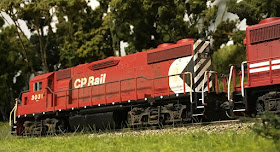In my previous post, I noted that I wanted to
vary the colour (add some darker green) and use longer fibres.
I got another package of static grass—darker green,
and 12 mm this time. (The first package was 6 mm.)
I experimented with a combination of shorter
and longer fibres, and I think I like the effect.
In truth, the longer fibres might be out of
scale for the average HO-sized person (about half the size of a 1:87 figure).
But for a full-scale human observer, it gives the
sense that the grass is deeper. And it shows up better in photos, too.
(I might take some scissors to the grass and
cut the taller fibres at random lengths; they look to uniform right now—in photos,
at least. In real life it’s not so noticeable.)
One challenge I had was what to do with the
areas where I had already added the shorter static grass.
Smearing glue on it to add the longer fibres wasn’t
an option; that would only flatten the existing grass.
Then I remembered how I made my trees, using
cheap hairspray to hold the ground foam to the “branches.” (Actually common plants
and weeds like spirea and yarrow.)
I tried it on the static grass, and it worked.
A spray to wet the scene, add the new fibres, then another light spray to hold
everything in place.
(Some websites and how-to videos actually
recommend a quick spray of hairspray to make sure everything stays fixed.)
After applying the static grass, I use a
home-made vacuum container made by my friend Larry Leavens to vacuum up any
other loose fibres. (He also made the applicator—clever guy!)
So far, I think it looks good. But I don’t
think I will apply it everywhere.
I think it will mostly go where I tend to
take photos—that’s where static grass helps make scenes look more believable.
Then again, who knows? Maybe once I get on a
roll, I’ll keep going.
















